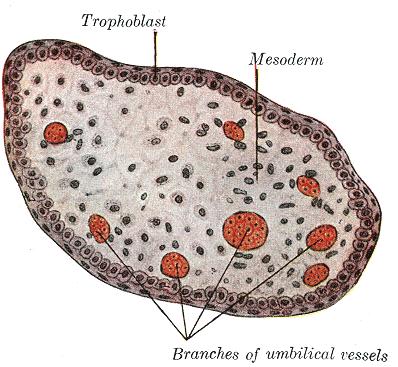Mesoderm: Difference between revisions
Brian Blank (talk | contribs) No edit summary |
Brian Blank (talk | contribs) No edit summary |
||
| Line 18: | Line 18: | ||
DorlandsSuf = | | DorlandsSuf = | | ||
}} | }} | ||
[[Image:Image19.png|thumb|350px|Transverse section of a chick embryo of forty-five hours' incubation.<br/> | [[Image:Image19.png|thumb|350px|Transverse section of a chick embryo of forty-five hours' incubation.<br/> | ||
* ''Chordamesoderm:'' yellow, at the [[notochord]].<br/> | * ''Chordamesoderm:'' yellow, at the [[notochord]].<br/> | ||
| Line 24: | Line 23: | ||
* ''Intermediate mesoderm:'' purple, which includes the [[Wolffian duct]].<br/> | * ''Intermediate mesoderm:'' purple, which includes the [[Wolffian duct]].<br/> | ||
* ''Lateral plate mesoderm:'' purple, comprising somatic and splanchic mesoderm.]] | * ''Lateral plate mesoderm:'' purple, comprising somatic and splanchic mesoderm.]] | ||
{{SI}} | {{SI}} | ||
{{CMG}} | {{CMG}} | ||
Revision as of 15:55, 28 May 2009

* Chordamesoderm: yellow, at the notochord.
* Paraxial mesoderm: red, comprising the somites.
* Intermediate mesoderm: purple, which includes the Wolffian duct.
* Lateral plate mesoderm: purple, comprising somatic and splanchic mesoderm.
|
WikiDoc Resources for Mesoderm |
|
Articles |
|---|
|
Most recent articles on Mesoderm |
|
Media |
|
Evidence Based Medicine |
|
Clinical Trials |
|
Ongoing Trials on Mesoderm at Clinical Trials.gov Clinical Trials on Mesoderm at Google
|
|
Guidelines / Policies / Govt |
|
US National Guidelines Clearinghouse on Mesoderm
|
|
Books |
|
News |
|
Commentary |
|
Definitions |
|
Patient Resources / Community |
|
Directions to Hospitals Treating Mesoderm Risk calculators and risk factors for Mesoderm
|
|
Healthcare Provider Resources |
|
Causes & Risk Factors for Mesoderm |
|
Continuing Medical Education (CME) |
|
International |
|
|
|
Business |
|
Experimental / Informatics |
Editor-In-Chief: C. Michael Gibson, M.S., M.D. [1]
Please Take Over This Page and Apply to be Editor-In-Chief for this topic: There can be one or more than one Editor-In-Chief. You may also apply to be an Associate Editor-In-Chief of one of the subtopics below. Please mail us [2] to indicate your interest in serving either as an Editor-In-Chief of the entire topic or as an Associate Editor-In-Chief for a subtopic. Please be sure to attach your CV and or biographical sketch.
Overview
The germ layer mesoderm forms in the embryos of animals more complex than cnidarians, making them triploblastic. Mesoderm forms during gastrulation when some of the cells migrating inward to form the endoderm form an additional layer between the endoderm and the ectoderm.
This key innovation evolved hundreds of millions of years ago and led to the evolution of nearly all large, complex animals. The formation of a mesoderm led to the formation of a coelom. Organs formed inside a coelom (body cavity) can freely move, grow, and develop independently of the body wall while fluid cushions and protects them from shocks.
Categorizing animals
Not all triploblastic animals have a coelom, like the simplest animals with organs that form from three tissue layers: flatworms. Three different configurations of mesoderm in relation to ectoderm form a method of categorizing animals.
- Acoelomates
- no coelom
- tissues and organs packed between gut and body wall
- Pseudocoelomates
- false coelom
- unlined or partially lined body cavity between gut and body wall
- Coelomates
- proper coelom
- lined cavity between gut and body wall
Derivatives
General
Note: Not all triploblasts produce all of the items listed.
- bones
- most of the circulatory system, including the heart and major blood vessels
- connective tissues of the gut and integuments
- mesenchyme
- mesothelium
- muscles
- peritoneum (lining of the coelom)
- reproductive system
- urinary system, including the kidneys
Vertebrates
In addition to the general list, the mesoderm of a developing vertebrate differentiates into the following:
See also
Additional images
-
Transverse section of a chorionic villus.
References
- Evers, Christine A., Lisa Starr. Biology:Concepts and Applications. 6th ed. United States:Thomson, 2006. ISBN 0-534-46224-3.
